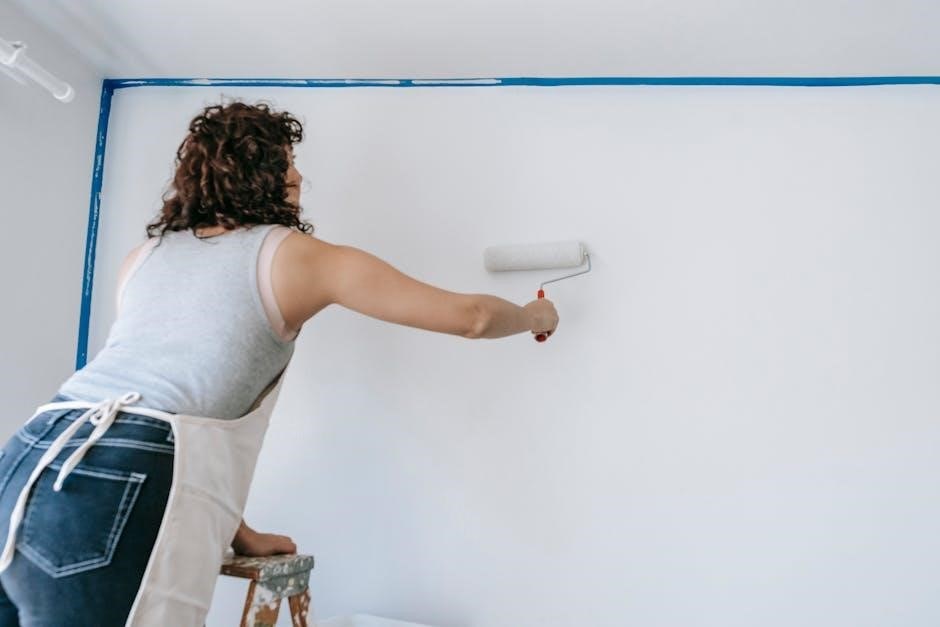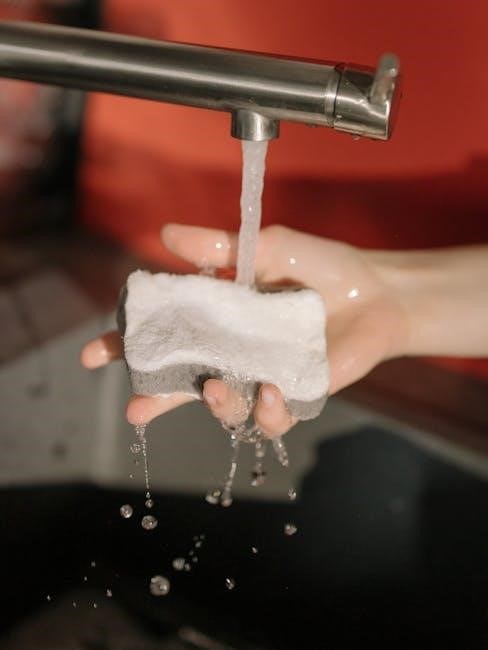house chores game guide

Transform boring household tasks into engaging activities with this guide. Discover fun strategies to make chores enjoyable, boost productivity, and foster teamwork among family members.
Gamifying house chores transforms mundane tasks into engaging activities, making them enjoyable and motivating for everyone. By incorporating elements like competition, rewards, and teamwork, chores become fun challenges rather than burdens. This approach encourages participation, fosters responsibility, and creates a sense of accomplishment. Whether it’s racing the clock to clean or turning laundry into a matching game, gamification breathes life into routine tasks, making them more manageable and enjoyable for the whole family.
Why Gamify Chores?
Gamifying chores increases motivation and engagement by turning tasks into enjoyable activities. It fosters teamwork, reduces resistance, and teaches responsibility while making the process fun. This method boosts productivity, encourages consistency, and helps create positive habits. By adding elements like rewards and competition, chores become less daunting, making it easier for everyone to contribute and feel a sense of achievement. Gamification is a simple yet effective way to transform daily tasks into rewarding experiences for the whole family.
Benefits of Turning Chores into Games
Turning chores into games offers numerous benefits, including increased productivity, improved teamwork, and enhanced motivation. It creates a sense of accomplishment and fosters responsibility, especially among children. By making tasks enjoyable, it reduces resistance and stress, encouraging consistent participation. Additionally, gamification promotes bonding through shared activities and healthy competition, while teaching essential life skills in a fun and engaging manner. This approach not only makes household tasks more manageable but also builds positive habits for the future.

Popular Games for Household Chores
Explore exciting games like “Cleaning for Speed,” “Laundry Pairs,” and “Dusty Buddy” to make chores fun. These activities turn tasks into engaging competitions for all ages.
Cleaning for Speed
Cleaning for Speed transforms tidying into a thrilling race against time. Set a timer and challenge family members to clean as much as possible before the buzzer sounds. This game fosters quick thinking and teamwork, making chores feel less daunting. Assign specific areas to each participant to ensure efficiency. The person who finishes first or achieves the most organized space wins. This method boosts productivity and turns cleaning into a fun, competitive activity for everyone involved. It’s a simple yet effective way to get the house spotless while enjoying quality time together.
Race the Clock to Clean
Race the Clock to Clean is a dynamic game that turns cleaning into a time-bound challenge. Set a timer for 10-15 minutes and encourage everyone to clean as much as possible within the time frame. Assign specific tasks or areas to each participant, fostering healthy competition. The person who completes their task first or achieves the most progress wins. This method not only speeds up cleaning but also makes it enjoyable, creating a sense of urgency and teamwork. It’s an excellent way to engage the whole family and maintain a tidy home.
Laundry: Find the Pairs
Transform laundry into a fun game with “Find the Pairs.” Separate clean socks and other matching items into a pile. Players race to find as many pairs as possible within a set time. Add excitement by setting a timer and rewarding the fastest matcher. This activity turns a mundane chore into a competitive yet bonding experience. It also teaches responsibility and teamwork, making laundry day enjoyable for everyone, especially kids, while keeping the task light and engaging;
Dusting: Dusty Buddy
Turn dusting into an interactive game with “Dusty Buddy;” Assign each player a section of the house and a set amount of time. Use colorful dusters or gloves to add fun. The goal is to dust as thoroughly as possible while racing the clock. You can even create a scoreboard to track progress. This game makes dusting a bonding experience, teaching kids responsibility and attention to detail. It also ensures the house stays clean while keeping the task enjoyable and engaging for everyone involved.
Setting the Table: Craft Cuisine
Transform table setting into a creative game with “Craft Cuisine.” Assign each player a role, like “Chef” or “Designer,” and challenge them to arrange utensils and plates artistically. Add a twist by incorporating themed settings, such as a formal dinner or a holiday feast. Time them and reward precision and flair. This game teaches organization and attention to detail, making the chore enjoyable while fostering creativity and teamwork among participants of all ages. It also prepares the table beautifully, ready for any meal.
Scavenger Hunt for Chores
Turn chores into an exciting adventure with a scavenger hunt. Create a list of tasks, such as finding dusty shelves or misplaced toys, and provide clues for each item. Hide small rewards or riddles related to the chores, making the process engaging. Involve the whole family, racing to complete tasks first. This game fosters teamwork, responsibility, and a sense of accomplishment, transforming mundane chores into a fun, collaborative activity that everyone will look forward to participating in together. It’s a creative way to keep your home tidy and organized while bonding as a family.
Sock-Match Race
Transform laundry day into a fun challenge with the Sock-Match Race. Separate clean socks and scatter them around the room. Players race to find matching pairs, fostering quick thinking and teamwork. Add excitement by setting a timer or dividing into teams. This game turns a tedious task into a lively activity, teaching responsibility while making chores enjoyable. It’s a simple yet effective way to engage everyone, ensuring the laundry gets done efficiently and with a smile. The race element adds motivation, making the process both productive and entertaining for all participants involved.
Bullseye Game
Turn chores into a competitive and fun activity with the Bullseye Game. Assign different point values to specific tasks, creating a “target” system where higher points are awarded for more challenging jobs. Players earn points by completing tasks, fostering a sense of accomplishment and friendly competition; This game works well for tasks like dusting, vacuuming, or organizing. The goal is to hit the “bullseye” by achieving the highest score, making chores engaging and rewarding while encouraging teamwork and accountability. It’s a creative way to make household tasks enjoyable and motivating for everyone involved.
Toy Pile Dismantle
This game transforms toy cleanup into an exciting challenge. Set a timer and have kids race to dismantle a messy toy pile, putting each item in its designated place. The twist? Each type of toy has a specific “point” value. For example, cars might be worth one point, while puzzles could be worth three. The child with the highest score at the end wins a small reward. This game turns a tedious task into a fun, competitive activity that teaches organization and speed while encouraging responsibility and teamwork. It’s a great way to keep kids engaged and motivated during cleanup sessions.
Assigning Tasks Effectively
Assigning tasks effectively ensures fairness and accountability. Clear communication and age-appropriate responsibilities help distribute chores evenly, fostering a sense of ownership and cooperation among family members.
Clear Task Assignment
Clear task assignment is essential for effective chore management. By defining specific roles and responsibilities, everyone understands their duties, reducing confusion and overlapping efforts. Use visual aids like checklists or charts to outline tasks, ensuring each person knows what’s expected. For example, assigning chores based on a dice roll or a random draw can add fun and fairness. This approach fosters accountability and encourages timely completion, making household tasks more manageable and less overwhelming for all involved.
Age-Appropriate Chore Allocation
Assigning chores based on age ensures tasks are manageable and suitable for each family member’s capabilities. Young children can start with simple tasks like picking up toys, while older kids can handle more complex duties like loading the dishwasher. Adults can oversee larger responsibilities, such as meal preparation or budget management. This approach fosters a sense of responsibility and fairness, making household contributions more balanced and effective. It also helps children develop essential life skills as they grow and take on more challenging tasks.
Using Chore Charts
Chore charts are a practical tool for organizing and tracking household tasks. They provide a clear visual reminder of responsibilities, fostering accountability and consistency. By listing tasks and assigning them to family members, charts help distribute work fairly. Use stickers, checkmarks, or color-coding to mark completed chores, offering a sense of accomplishment. Charts can be customizable, incorporating fun elements like rewards or penalties. This simple yet effective system makes task management engaging and ensures everyone contributes, promoting teamwork and a balanced household workload.
Reward Systems
Reward systems motivate consistency and teamwork by offering incentives. Stickers, stars, or points encourage effort. Tangible rewards and verbal praise create a positive, engaging atmosphere, making chores enjoyable and rewarding.
Points System
A points system is a motivating way to track progress. Assign points to each chore, with harder tasks worth more. Points can be redeemed for rewards, fostering a sense of achievement. This method encourages healthy competition and consistent effort, making chores feel rewarding and fun. Over time, it helps build responsibility and a habit of contributing to household tasks. The visibility of earned points keeps everyone motivated and engaged in reaching their goals together.
Tangible Rewards
Tangible rewards provide immediate, physical incentives for completing chores. Examples include stickers, small toys, or treats. These rewards motivate individuals, especially children, by offering something concrete to look forward to. Implementing a reward system with tangible items encourages consistent effort and responsibility. It fosters a sense of accomplishment and satisfaction, making chores more appealing. Over time, this approach helps build a habit of contributing to household tasks while keeping everyone engaged and motivated. Tangible rewards are effective because they offer a clear and satisfying outcome for effort.
Verbal Praise
Verbal praise is a powerful motivator that boosts morale and encourages consistent effort. Acknowledging achievements with words of encouragement fosters a sense of accomplishment. It strengthens self-esteem and reinforces positive behavior, making tasks feel more rewarding. Praise can be simple, like “Great job!” or specific, highlighting effort and progress. This approach builds confidence and teamwork, creating a supportive environment where everyone feels valued for their contributions. Verbal praise is an effective way to keep individuals motivated without relying solely on tangible rewards.

Technology and Apps
Technology and apps transform chores into interactive games, offering features like points, rewards, and progress tracking. Apps such as Habitica turn tasks into gamified experiences, enhancing engagement and fun through digital tools.
Habitica: Turning Life into a Game
Habitica is a habit-building app that transforms chores and tasks into a gamified experience. Users earn rewards, complete quests, and level up their avatar by finishing tasks. By integrating chores into a virtual game, Habitica makes daily responsibilities fun and engaging. It encourages consistency and accountability through a unique blend of productivity and play, turning life into an adventure. This approach not only boosts productivity but also makes household tasks enjoyable for everyone involved. It’s a creative way to stay motivated and have fun while getting things done.
Chore Apps with Gamification Features
Chore apps like Tody and ChoreMonster bring fun to household tasks by incorporating game-like elements. These apps use points, rewards, and leaderboards to motivate users. Tody allows users to earn stars for completing tasks, while ChoreMonster offers tangible rewards like extra screen time. By turning chores into a game, these apps foster accountability and teamwork. They also provide real-time tracking, making it easy to monitor progress. Such tools are perfect for families and individuals seeking to make household responsibilities enjoyable and rewarding through gamification. They simplify task management while keeping it engaging for all ages.

Family Participation
Engage everyone in household tasks by creating a collaborative environment. Assign roles and celebrate achievements together to foster teamwork and responsibility while making chores enjoyable for all ages.
Involving Kids in Chores
Incorporate children into household tasks by making chores interactive and age-appropriate. Use games like scavenger hunts or races to encourage participation. Assign clear, simple tasks to build their sense of responsibility. Praise their efforts to boost motivation. Provide rewards for consistency, fostering a habit of contributing to the family. This approach not only teaches life skills but also strengthens family bonds through shared activities. Make chores fun and engaging for kids to ensure they grow into responsible individuals.
Team-Based Chore Games
Foster collaboration with team-based games, turning chores into bonding experiences. Divide tasks among family members, assigning roles to create a sense of unity. Use challenges like timed cleanups or relay races to add excitement. Encourage teamwork by setting common goals, such as completing tasks together to earn rewards. Celebrate collective achievements to reinforce the value of cooperation. This approach not only makes chores more enjoyable but also strengthens family ties through shared efforts and mutual support, creating lasting memories.
Long-Term Consistency
Sustain engagement by maintaining routines and rewarding progress. Consistent schedules and positive reinforcement ensure chores remain enjoyable and habitual, fostering a culture of responsibility and teamwork.
Creating a Chore Schedule
A well-structured chore schedule is key to maintaining long-term consistency. Assign tasks based on frequency and importance, ensuring clarity for all participants. Use visual tools like charts or calendars to track progress. Set realistic deadlines and rotate duties to keep things fair and engaging. Incorporate flexibility for unexpected tasks and involve the whole family in planning. This approach fosters responsibility, reduces conflicts, and ensures chores are completed efficiently. Consistency breeds habit, making household management smoother over time.
Celebrating Milestones
Celebrating milestones is a powerful way to motivate and acknowledge progress in chore completion. Recognize achievements like completing a week of tasks or reaching a certain number of points. Small rewards, verbal praise, or fun family activities can reinforce efforts. This encourages consistency and builds a sense of accomplishment. Milestones also provide opportunities to reflect on improvements and set new goals. By celebrating successes, you foster a positive environment and keep the momentum going, making chores feel rewarding and enjoyable for everyone involved.
Safety and Responsibility
Ensure tasks are completed safely and responsibly. Assign age-appropriate chores and provide clear instructions to avoid accidents. Teach accountability for maintaining a secure and organized home environment.
Ensuring Safe Chore Completion
Ensure tasks are completed safely by assigning age-appropriate chores and providing clear instructions. Supervise younger children during tasks to prevent accidents. Conduct safety briefings for potentially hazardous tasks, such as handling sharp objects or cleaning chemicals. Encourage the use of protective gear when necessary. Teach proper techniques for lifting heavy items or using household tools. Regularly inspect tasks to ensure they are done safely and correctly. This approach fosters a secure environment while teaching responsibility and practical life skills.
Teaching Responsibility
Teach responsibility by assigning specific chores and explaining their importance. Supervise younger children to guide them and ensure tasks are completed safely. Encourage accountability by linking chores to rewards or privileges. Praise effort and progress, fostering a sense of accomplishment. Help children understand how their contributions benefit the household. Over time, they’ll develop a strong work ethic and readiness to take on more responsibilities independently.
Real-Life Examples
Families worldwide share success stories of turning chores into games. One family transformed cleaning into a race, completing tasks efficiently while having fun. Another used scavenger hunts for laundry, making it exciting for kids to participate.
Case Studies of Successful Chore Gamification
Families globally have successfully turned chores into games, boosting productivity and fun. A household in California implemented a “speed cleaning race,” reducing cleanup time by 40%. Another family in London used a scavenger hunt for laundry, making it a bonding activity. A Swedish family created a “Dusty Buddy” game for dusting, turning a tedious task into a playful competition. These examples highlight how gamification can transform chores into enjoyable experiences, fostering teamwork and responsibility among all members.
Testimonials from Families
Families worldwide share their positive experiences with chore gamification. One parent stated, “Turning chores into games has made our household more efficient and joyful.” Another family noted, “Our kids now eagerly participate in cleaning races, making it a fun bonding time.” A couple mentioned, “Using apps like Habitica has transformed our chores into a game, making it easier to stay motivated.” These testimonials highlight the transformative impact of gamifying household tasks, creating a sense of accomplishment and unity among family members, while keeping the home tidy and organized.

Future Trends
The future of chore games lies in augmented reality and virtual rewards, making tasks more immersive and fun, while enhancing motivation and engagement for all ages.
Augmented Reality in Chores
Augmented reality (AR) is revolutionizing household tasks by turning them into immersive, interactive experiences. AR can transform cleaning into a game where users interact with virtual objects, such as erasing digital messes or solving spatial puzzles. This technology offers real-time feedback, guiding users on optimal cleaning paths or organization strategies. AR also introduces social elements, like competing with friends to clean virtual spaces fastest. Such innovations make chores engaging, educational, and fun, fostering a new level of motivation and efficiency in household management.
Virtual Rewards
Virtual rewards are a motivating factor in gamifying chores, offering a sense of achievement without physical prizes. Apps like Habitica transform tasks into game-like experiences, where completing chores earns points or unlocks virtual items. These rewards can be customized, such as badges, trophies, or progress toward in-app goals. Virtual rewards foster a sense of accomplishment and encourage consistent participation, especially among tech-savvy individuals who enjoy digital recognition. This approach aligns with modern trends, making household tasks more engaging and rewarding in a virtual space.
Gamifying chores creates a fun, productive environment, fostering teamwork and responsibility. Start your journey today and turn household tasks into enjoyable, rewarding experiences for everyone involved!
Starting Your Chore Game Journey
Begin by assigning clear, age-appropriate tasks and introducing simple games like scavenger hunts or speed races. Use apps like Habitica to track progress and reward achievements. Involve the whole family, fostering teamwork and responsibility. Consistency is key—celebrate milestones to maintain motivation. With creativity and persistence, chores become enjoyable, teaching valuable life skills and strengthening family bonds. Start small, stay consistent, and watch your household transform into a collaborative, productive, and fun environment where everyone contributes happily.
Additional Resources
Explore Chore Apps with gamification features like ChoreMonster or Tody for interactive task management. Check out websites offering printable chore charts and creative game ideas. Follow family blogs sharing success stories and tips for engaging kids. Visit platforms like Pinterest for visual inspiration and-step guides. Utilize YouTube tutorials demonstrating fun chore games. Encourage families to experiment with these tools to keep chores engaging and tailored to their unique needs, ensuring long-term success and enjoyment in maintaining a tidy, cooperative home environment.